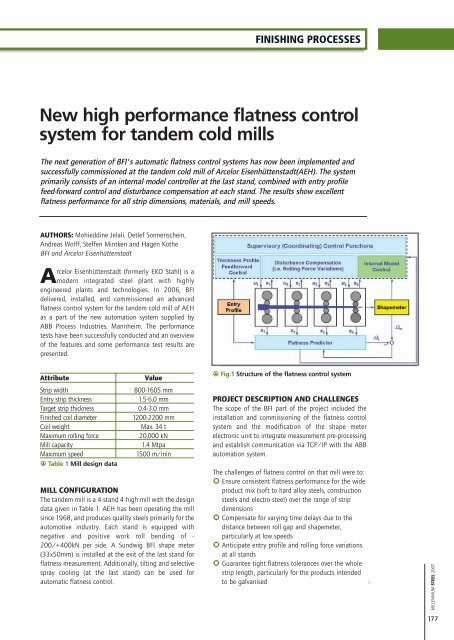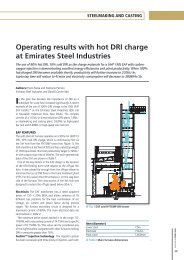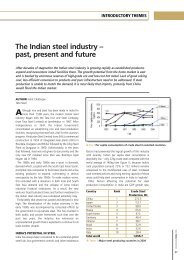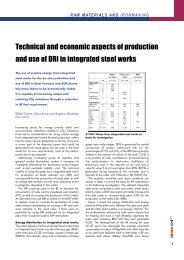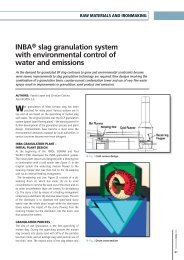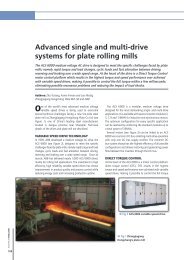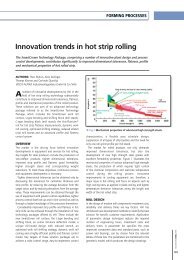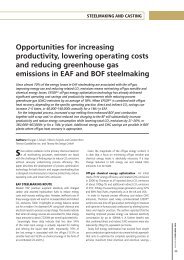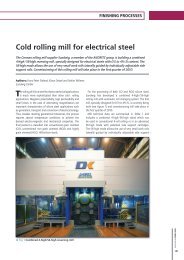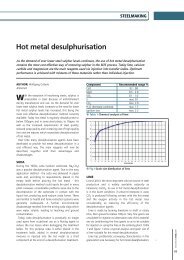pp177-179 MS07.pdf - Millennium Steel
pp177-179 MS07.pdf - Millennium Steel
pp177-179 MS07.pdf - Millennium Steel
Create successful ePaper yourself
Turn your PDF publications into a flip-book with our unique Google optimized e-Paper software.
New high performance flatness control<br />
system for tandem cold mills<br />
The next generation of BFI's automatic flatness control systems has now been implemented and<br />
successfully commissioned at the tandem cold mill of Arcelor Eisenhüttenstadt(AEH). The system<br />
primarily consists of an internal model controller at the last stand, combined with entry profile<br />
feed-forward control and disturbance compensation at each stand. The results show excellent<br />
flatness performance for all strip dimensions, materials, and mill speeds.<br />
AUTHORS: Mohieddine Jelali, Detlef Sonnenschein,<br />
Andreas Wolff, Steffen Mintken and Hagen Kothe<br />
BFI and Arcelor Eisenhüttenstadt<br />
Arcelor Eisenhüttenstadt (formerly EKO Stahl) is a<br />
modern integrated steel plant with highly<br />
engineered plants and technologies. In 2006, BFI<br />
delivered, installed, and commissioned an advanced<br />
flatness control system for the tandem cold mill of AEH<br />
as a part of the new automation system supplied by<br />
ABB Process Industries, Mannheim. The performance<br />
tests have been successfully conducted and an overview<br />
of the features and some performance test results are<br />
presented.<br />
Attribute Value<br />
Strip width 800-1605 mm<br />
Entry strip thickness 1.5-6.0 mm<br />
Target strip thickness 0.4-3.0 mm<br />
Finished coil diameter 1200-2200 mm<br />
Coil weight Max. 34 t<br />
Maximum rolling force 20,000 kN<br />
Mill capacity 1.4 Mtpa<br />
Maximum speed<br />
r Table 1 Mill design data<br />
1500 m/min<br />
MILL CONFIGURATION<br />
The tandem mill is a 4-stand 4-high mill with the design<br />
data given in Table 1. AEH has been operating the mill<br />
since 1968, and produces quality steels primarily for the<br />
automotive industry. Each stand is equipped with<br />
negative and positive work roll bending of -<br />
200/+400kN per side. A Sundwig BFI shape meter<br />
(33x50mm) is installed at the exit of the last stand for<br />
flatness measurement. Additionally, tilting and selective<br />
spray cooling (at the last stand) can be used for<br />
automatic flatness control.<br />
FINISHING PROCESSES<br />
r Fig.1 Structure of the flatness control system<br />
PROJECT DESCRIPTION AND CHALLENGES<br />
The scope of the BFI part of the project included the<br />
installation and commissioning of the flatness control<br />
system and the modification of the shape meter<br />
electronic unit to integrate measurement pre-processing<br />
and establish communication via TCP/IP with the ABB<br />
automation system.<br />
The challenges of flatness control on that mill were to:<br />
` Ensure consistent flatness performance for the wide<br />
product mix (soft to hard alloy steels, construction<br />
steels and electro-steel) over the range of strip<br />
dimensions<br />
` Compensate for varying time delays due to the<br />
distance between roll gap and shapemeter,<br />
particularly at low speeds<br />
` Anticipate entry profile and rolling force variations<br />
at all stands<br />
` Guarantee tight flatness tolerances over the whole<br />
strip length, particularly for the products intended<br />
to be galvanised<br />
a<br />
MILLENNIUM STEEL 2007<br />
177
MILLENNIUM STEEL 2007<br />
178<br />
r Fig.2 Structure of the internal flatness control<br />
model<br />
r Fig.3 Main pulpit control screens<br />
r Fig.4 Example of screen display<br />
CONTROL SYSTEM OVERVIEW<br />
The new control system concept mainly consists of the<br />
following components (see Fig. 1):<br />
` Anticipation of incoming strip thickness profile<br />
deviations at the first stand by bending trims<br />
` Compensation of the rolling force changes at all<br />
stands by bending trims<br />
` Internal model control (IMC) at the last stand (see<br />
Fig. 2), with schedule-dependent parameters. IMC<br />
provides time delay compensation and is very<br />
robust against modelling errors. Tuning is<br />
straightforward as only one parameter remains to<br />
be selected for each actuator control loop, which is<br />
very appealing in practice. The IMC is designed<br />
based on the measured flatness deviations, on-line<br />
pre-processed by Gram polynomial decomposition,<br />
thus the actual controlled variables are the<br />
polynomial coefficients.<br />
` Flatness predictor for on-line estimation of the<br />
interstand flatness and adaptation of the transfer<br />
functions of the control system, depending on the<br />
actual mill situation<br />
` Supervisory control level for coordinating the local<br />
controllers depending on the mill conditions and<br />
pre-selected control loops<br />
More details on flatness controller design can be found<br />
in earlier publications [1, 2].<br />
TARGET PLATFORM AND INTERFACES<br />
The new flatness control system has been implemented<br />
on an ABB controller AC800PEC, providing maximum<br />
computation power, and is fully integrated into the new<br />
automation system, establishing communication to the<br />
other process controllers (basic controls, setup system)<br />
and to the (InTouch) HMI system via optical<br />
links and Ethernet TCP/IP, respectively.<br />
Special attention was paid to the design of<br />
the tandem mill's main control pulpit (see<br />
figures 3 and 4). Other screens, not shown<br />
here, are also provided for calibration of the<br />
shape meter and for visualisation of entry<br />
thickness profile and of the predicted<br />
interstand flatness.<br />
All information required for the operating<br />
staff, such as reference and measured flatness,<br />
reference and actual actuator states and<br />
values, is displayed on the monitor. The<br />
operator can individually activate/disable<br />
single control loops and enter/change the<br />
reference curves for the flatness control at the<br />
control desk. Important data for quality<br />
management are sent to an IBA system.
FINISHING PROCESSES<br />
r Fig.5 Typically achieved flatness control performance (top: flatness in µm/m; bottom: applied bending force [kN])<br />
Strip width, mm Strip thickness h4, mm<br />
0.4, 0.7 0.7, 1.2 h4 ≥ 1.2<br />
800, 1200 7.2 5.8 3.7<br />
1200, 1500 5.6 6.0 3.4<br />
r Table 2 Typically achieved flatness performance<br />
I-units (IU)<br />
RESULTS<br />
Extensive preparation work allowed the flatness control<br />
system to start up after a few days. Subsequently the<br />
control system functions have been optimised to<br />
achieve the guaranteed performance values. Excellent<br />
flatness performance in the range of 4 to 7 flatness IU<br />
is delivered by the new flatness control system; (see<br />
Table 2). In contrast to the situation prior to the revamp,<br />
the system is operating by default in auto-mode using<br />
all actuator controls (bending at stands 1 to 3, and<br />
bending, tilting, and selective cooling at the last stand)<br />
with minimum operator trimming. Figure 5 shows some<br />
typical results of the flatness control for thin strip.<br />
CONCLUDING REMARKS<br />
The successful completion of the project offers AEH the<br />
opportunity to meet highest quality demands in terms<br />
of strip flatness. The successful design, implementation<br />
and commissioning of this project represents an<br />
important example of the capability of BFI to manage a<br />
challenging project involving a new control technology<br />
as well as major modernisation activities. BFI is now<br />
working on the adaptation of the control system to<br />
other configurations, such as 6-high and cluster mills.<br />
REFERENCES<br />
[1] Jelali M., Müller U., Ungerer W., Wolff A., Fackert R.<br />
New system for strip flatness control during hot rolling.<br />
<strong>Millennium</strong> <strong>Steel</strong> 2002, p. 174-178.<br />
[2] Jelali M., Wolff A., Kpper H., Schiller M. Improved<br />
flatness in EKO's tandem cold mill. La Revue de<br />
Métallurgie-CIT, October 2003, p. 987-992.<br />
Mohieddine Jelali is Vice-Head of Department Industrial<br />
Plant and System Technology at<br />
Betriebsforschungsinstitut (BFI), VDEh-Institut für<br />
Angewandte Forschung GmbH, Düsseldorf, Germany.<br />
Detlef Sonnenschein and Andreas Wolff are with the<br />
BFI. Steffen Mintken and Hagen Kothe are with Arcelor<br />
Eisenhüttenstadt (AEH), Eisenhüttenstadt., Germany.<br />
CONTACT: mohieddine.jelali@bfi.de<br />
MILLENNIUM STEEL 2007<br />
<strong>179</strong>


